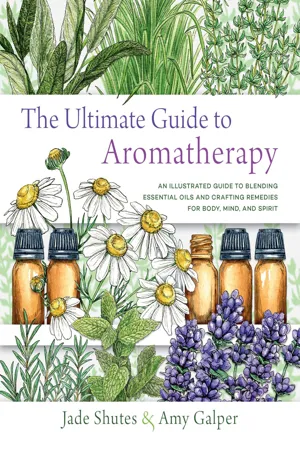
The Ultimate Guide to Aromatherapy
An Illustrated guide to blending essential oils and crafting remedies for body, mind, and spirit
- 208 pages
- English
- ePUB (mobile friendly)
- Available on iOS & Android
The Ultimate Guide to Aromatherapy
An Illustrated guide to blending essential oils and crafting remedies for body, mind, and spirit
About This Book
Written by two of the leading voices in aromatherapy, Amy Galper and Jade Shutes, The Ultimate Guide to Aromatherapy is a progressive, comprehensive approach to using aromatherapy and essential oils for healing and wellness. Essentials oils have been used across all world cultures for thousands of years. While the popularity of aromatherapy has endured, the methods and applications of the craft have evolved. The Ultimate Guide to Aromatherapy is the modern practitioner's guide to working with aromatherapy and essential oils. Using techniques developed over decades of teaching, you will learn the science of aromatherapy and how essentials oils interact with our sense of smell, brain pathways, and skin. The guide also includes over 50 plant profiles, plus recipes and blends for health and beauty. Included are remedies for digestive health, immunity, women's health concerns, and more, such as Hand & Body Wash for Flu Recovery, Self-Love Botanical Perfume, and Tummy Massage Oil for Indigestion. Drawing on the authors' unique methodologyand expertiseas aromatherapists, herbalists, and healers, you will learn the art of blending formulations with great skill and discernment. The Ultimate Guide to… series offers comprehensive beginner's guides to discovering a range of mind, body, spirit topics, including tarot, divination, crystal grids, numerology, witchcraft, chakras, and more. Filled with beautiful illustrations and designed to give easy access to the information you're looking for, each of these references provides simple-to-follow expert guidance as you learn and master your practice.
Frequently asked questions
Information
PART I
About Aromatherapy

CHAPTER ONE
THE NEW AROMATHERAPY
A LITTLE HISTORY
Table of contents
- Cover
- Title Page
- Contents
- Essential Oils
- Introduction
- Part I: About Aromatherapy
- Part II: Pathways Into the Body
- Part III: The Essential Apothecary
- Part IV: Methods of Use (Application)
- Part V: Putting it All Together
- Resources
- About the Authors
- Acknowledgments
- Endnotes
- Index
- Copyright